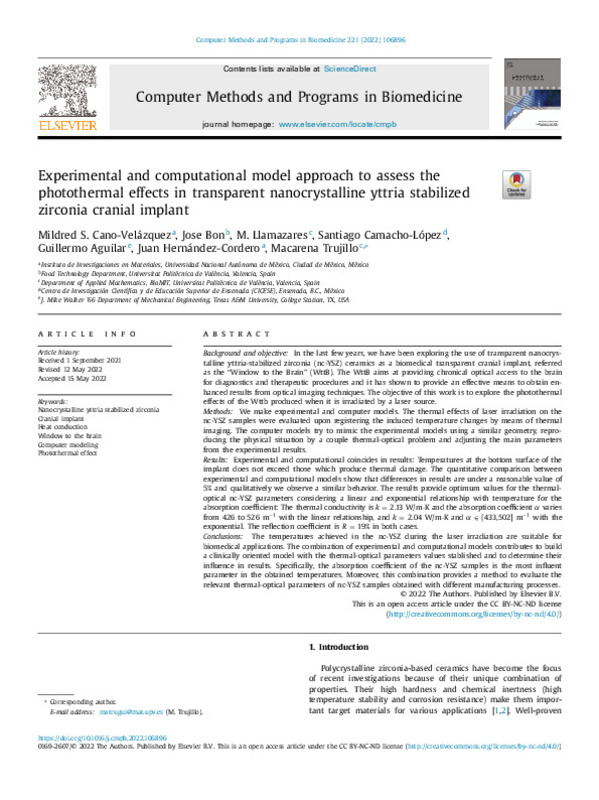JavaScript is disabled for your browser. Some features of this site may not work without it.
Buscar en RiuNet
Listar
Mi cuenta
Estadísticas
Ayuda RiuNet
Admin. UPV
Experimental and computational model approach to assess the photothermal effects in transparent nanocrystalline yttria stabilized zirconia cranial implant
Mostrar el registro sencillo del ítem
Ficheros en el ítem
| dc.contributor.author | Cano-Velázquez, Mildred S.
|
es_ES |
| dc.contributor.author | Bon Corbín, José
|
es_ES |
| dc.contributor.author | Llamazares, M.
|
es_ES |
| dc.contributor.author | Camacho-López, Santiago
|
es_ES |
| dc.contributor.author | Aguilar, Guillermo
|
es_ES |
| dc.contributor.author | Hernández-Cordero, Juan
|
es_ES |
| dc.contributor.author | Trujillo Guillen, Macarena
|
es_ES |
| dc.date.accessioned | 2023-07-04T18:01:38Z | |
| dc.date.available | 2023-07-04T18:01:38Z | |
| dc.date.issued | 2022-06 | es_ES |
| dc.identifier.issn | 0169-2607 | es_ES |
| dc.identifier.uri | http://hdl.handle.net/10251/194673 | |
| dc.description.abstract | [EN] Background and objective: In the last few years, we have been exploring the use of transparent nanocrystalline yttria-stabilized zirconia (nc-YSZ) ceramics as a biomedical transparent cranial implant, referred as the "Window to the Brain " (WttB). The WttB aims at providing chronical optical access to the brain for diagnostics and therapeutic procedures and it has shown to provide an effective means to obtain enhanced results from optical imaging techniques. The objective of this work is to explore the photothermal effects of the Wttb produced when it is irradiated by a laser source. Methods: We make experimental and computer models. The thermal effects of laser irradiation on the nc-YSZ samples were evaluated upon registering the induced temperature changes by means of thermal imaging. The computer models try to mimic the experimental models using a similar geometry, reproducing the physical situation by a couple thermal-optical problem and adjusting the main parameters from the experimental results. Results: Experimental and computational coincides in results: Temperatures at the bottom surface of the implant does not exceed those which produce thermal damage. The quantitative comparison between experimental and computational models show that differences in results are under a reasonable value of 5% and qualitatively we observe a similar behavior. The results provide optimum values for the thermal optical nc-YSZ parameters considering a linear and exponential relationship with temperature for the absorption coefficient: The thermal conductivity is k = 2.13 W/mmiddotK and the absorption coefficient alpha varies from 426 to 526 m(-1) with the linear relationship, and k = 2.04 W/mmiddotK and alpha is an element of [433,502] m(-1) with the exponential. The reflection coefficient is R = 19% in both cases. Conclusions: The temperatures achieved in the nc-YSZ during the laser irradiation are suitable for biomedical applications. The combination of experimental and computational models contributes to build a clinically oriented model with the thermal-optical parameters values stablished and to determine their influence in results. Specifically, the absorption coefficient of the nc-YSZ samples is the most influent parameter in the obtained temperatures. Moreover, this combination provides a method to evaluate the relevant thermal-optical parameters of nc-YSZ samples obtained with different manufacturing processes. | es_ES |
| dc.description.sponsorship | This work was supported by the Spanish Ministerio de Ciencia, Innovacion y Universidades under "Programa Estatal de I + D + I Orientada a los Retos de la Sociedad", Grant No. "RTI2018- 094357-B-C21". The WttB project is being funded by NSF through grants NSF-PIRE 1545852, NSF-EAGER 1547014 and by CONACYT (Mexico) through FORDECyT-PRONACES, Grant 246648. M.S.C.V. acknowledges support from "Beca Mixta, Grant 741249" (CONACYT, Mexico) . | es_ES |
| dc.language | Inglés | es_ES |
| dc.publisher | Elsevier | es_ES |
| dc.relation.ispartof | Computer Methods and Programs in Biomedicine | es_ES |
| dc.rights | Reconocimiento - No comercial - Sin obra derivada (by-nc-nd) | es_ES |
| dc.subject | Nanocrystalline yttria stabilized zirconia | es_ES |
| dc.subject | Cranial implant | es_ES |
| dc.subject | Heat conduction | es_ES |
| dc.subject | Window to the brain | es_ES |
| dc.subject | Computer modeling | es_ES |
| dc.subject | Photothermal effect | es_ES |
| dc.subject.classification | TECNOLOGIA DE ALIMENTOS | es_ES |
| dc.subject.classification | MATEMATICA APLICADA | es_ES |
| dc.title | Experimental and computational model approach to assess the photothermal effects in transparent nanocrystalline yttria stabilized zirconia cranial implant | es_ES |
| dc.type | Artículo | es_ES |
| dc.identifier.doi | 10.1016/j.cmpb.2022.106896 | es_ES |
| dc.relation.projectID | info:eu-repo/grantAgreement/AEI/Plan Estatal de Investigación Científica y Técnica y de Innovación 2017-2020/RTI2018-094357-B-C21/ES/MODELADO Y EXPERIMENTACION PARA TERAPIAS ABLATIVAS INNOVADORAS/ | es_ES |
| dc.relation.projectID | info:eu-repo/grantAgreement/NSF//NSF-EAGER 1547014//WttB project/ | es_ES |
| dc.relation.projectID | info:eu-repo/grantAgreement/NSF//NSF-PIRE 1545852//WttB project/ | es_ES |
| dc.relation.projectID | info:eu-repo/grantAgreement/CONACYT//741249//Beca Mixta/ | es_ES |
| dc.relation.projectID | info:eu-repo/grantAgreement/CONACYT//246648//FORDECyT-PRONACES/ | es_ES |
| dc.rights.accessRights | Abierto | es_ES |
| dc.contributor.affiliation | Universitat Politècnica de València. Escuela Técnica Superior de Arquitectura - Escola Tècnica Superior d'Arquitectura | es_ES |
| dc.contributor.affiliation | Universitat Politècnica de València. Escuela Técnica Superior de Ingeniería Agronómica y del Medio Natural - Escola Tècnica Superior d'Enginyeria Agronòmica i del Medi Natural | es_ES |
| dc.description.bibliographicCitation | Cano-Velázquez, MS.; Bon Corbín, J.; Llamazares, M.; Camacho-López, S.; Aguilar, G.; Hernández-Cordero, J.; Trujillo Guillen, M. (2022). Experimental and computational model approach to assess the photothermal effects in transparent nanocrystalline yttria stabilized zirconia cranial implant. Computer Methods and Programs in Biomedicine. 221:1-11. https://doi.org/10.1016/j.cmpb.2022.106896 | es_ES |
| dc.description.accrualMethod | S | es_ES |
| dc.relation.publisherversion | https://doi.org/10.1016/j.cmpb.2022.106896 | es_ES |
| dc.description.upvformatpinicio | 1 | es_ES |
| dc.description.upvformatpfin | 11 | es_ES |
| dc.type.version | info:eu-repo/semantics/publishedVersion | es_ES |
| dc.description.volume | 221 | es_ES |
| dc.identifier.pmid | 35617809 | es_ES |
| dc.relation.pasarela | S\467246 | es_ES |
| dc.contributor.funder | AGENCIA ESTATAL DE INVESTIGACION | es_ES |
| dc.contributor.funder | National Science Foundation, EEUU | es_ES |
| dc.contributor.funder | Consejo Nacional de Ciencia y Tecnología, México | es_ES |








